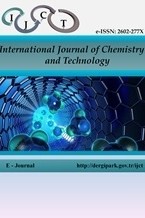HyperChem programı kullanarak bazı aromatik karboksilik asitlerin HOMO, LUMO, termoplastik özellikleri ve QSAR incelemesinin teorik araştırılması
Kimyasalların moleküler mekanizmasını geliştirmek, termokimyasal ve biyolojik etkileşimler hesaplamalı kimyanın temel amacı olarak düşünülmektedir. Moleküllerin serbest enerjisi, entropisi, dipol momenti, bağlanma enerjisi, nükleer enerjisi, elektronik enerjisi, oluşum ısısı gibi bazı termodinamik parametreleri ve yük yoğunluğu, yüzey alanı ızgarası, hacim, LogP, polarizasyon, kırılma, moleküler kütle gibi QSAR (kantitatif yapı aktivite ilişkisi) özellikleri, ve HOMO (en yüksek dolu moleküler orbital), ve LUMO (en düşük boş moleküler orbital), HUMO (en yüksek boş moleküler orbital)- LUMO enerji aralığı, iyonlaşma potansiyeli ve elektron afinitesi gibi reaktivite özellikleri, HyperChem 8.0.10 programı kullanılarak belirlenmiştir. Hesaplanan QSAR parametreleri, insan vücudundaki biyolojik aktivite ve metabolizmanın tahmininde önemli bir role sahiptir.
Anahtar Kelimeler:
HyperChem 8.0.10, aromatik karboksilik asit, QSAR, HOMO-LUMO
The theoretical investigation of HOMO, LUMO, thermophysical properties and QSAR study of some aromatic carboxylic acids using HyperChem programming
Growing the molecular mechanism of chemicals, thermochemical and biological interactions is considered as the ultimate goal of computational chemistry. Some thermodynamic parameters such as free energy, entropy, dipole moment, binding energy, nuclear energy, electronics energy, heat of formation, and QSAR (quantitative structure activity relationship) properties of molecules like charge density, surface area grid, volume, LogP, polarizability, refractivity, molecular mass, and reactivity properties of molecules like HOMO (the highest occupied molecular orbital), LUMO (the lowest unoccupied molecular orbital), HUMO (the highest unoccupied molecular orbital )-LUMO gap, ionization potential and electron affinity were determined using the HyperChem 8.0.10 program. The computed QSAR parameters have a significant role in the estimation of the biological activity and metabolism in the human body.
Keywords:
Hyperchem 8.0.10, aromatic carboxylic acid, QSAR, HOMO-LUMO,
___
- 1. Bridges, J.; French, M.; Smith, R.; Williams, R. Biochem. J. 1970, 118, 47-51.
- 2. Chou, S.; Huang, C. Chemosphere 1999, 38, 2719-2731.
- 3. Nayak, J.; Sahu, S.; Kasuya, J.; Nozaki, S. Appl. Surf. Sci. 2008, 254, 7215-7218.
- 4. Mroz, Z. Advances in Pork Production 2005, 16, 169-182.
- 5. Doherty, H. M.; Selvendran, R. R.; Bowles, D. J. Physiol. Mol. Plant P. 1988, 33, 377-384.
- 6. Hazan, R.; Levine, A.; Abeliovich, H. Appl. Env. Microbiol. 2004, 70, 4449-4457.
- 7. Salmond, C. V.; Kroll, R. G.; Booth, I. R. J. Gen. Microbiol. 1984, 130, 2845-2850.
- 8. Sakata, Y.; Ponec, V. Appl. Catal A- GEN. 1998, 166, 173-184.
- 9. Kluge, H.; Broz, J.; Eder, K. J. Anim. Physiol. An. N. 2006, 90, 316-324.
- 10. Arendt, W. D.; Bohnert, T. J.; Holt, M. S. Google Patents, 2001.
- 11. Stauffer, D.; Puletti, P. Google Patents, 1993.
- 12. McBride, W. D.; Catherine, G.; Linda F.; Ali, M. The U.S. Department of Agriculture (USDA), 2015, 188.
- 13. Ritz, J.; Fuchs, H.; Kieczka, H.; Moran, W. C. Ullmann's Ency. Ind. Chem. 2000.
- 14. Talukdar, J.; Wong, E. H. S.; Mathur, V. K. Sol. Energy 1991, 47, 165-171.
- 15. Zeng, Z.; Zhou, R. Google Patents, 2014.
- 16. Kyle, A. A.; Dahl, M. V. Am. J. Clin. Dermatol. 2004, 5, 443-451.
- 17. Akhtar, N.; Verma, A.; Pathak, K. Curr. Pharm. Design.2015, 21, 2892-2913.
- 18. Amborabé, B.-E.; Fleurat-Lessard, P.; Chollet, J.-F.; Roblin, G. Plant. Physiol.Biochem. 2002, 40, 1051-1060.
- 19. Benchea, A. C.; G Marius; Dorohoi, D. O. Construcţii de Maşini. 2016, 62, 41-50.
- 20. Waterman, M. S. Introduction to computational biology: maps, sequences and genomes, C. R. C. Press, 1995.
- 21. Dwyer, M. A.; Looger, L. L.; Hellinga, H. W. Science 2004, 304, 1967-1971.
- 22. Yap, C. W. J. Comput. Chem. 2011, 32, 1466-1474
- 23. Gramatica, P.; Papa, E. QSAR & Combinatorial Science 2003, 22, 374-385.
- 24. Xia, B.; Ma, W.; Zheng, B.; Zhang, X.; Fan, B. Eur. J. Med. Chem. 2008, 43, 1489-1498.
- 25. Raies, A. B.; Bajic, V. B. WIREs: Comput. Mol. Sci. 2016, 6, 147-172.
- 26. Shahpar, M.; Esmaeilpoor, S. Asian J. Green Chem. 2017, 2, 116-129.
- 27. Smith, D. M.; Mitchell, J. Analyt. Chem. 1950, 22(6), 750-755.
- 28. Kaufman, L.; Cohen, M. Prog. Met. Phys. 1958, 7, 165-246.
- 29. Shapiro, A. H. The dynamics and thermodynamics of compressible fluid flow. Vol.1, Wiley, New York, 1953.
- 30. Guggenheim, E. A. Thermodynamics- An advanced treatment for chemists and physicsists. Amsterdam, North-Holland, p.414, 1985.
- 31. Von Bertalanffy, L. Science 1950, 111, 23-29.
- 32. Frank, H. S.; Evans, M. W. J. Chem. Phys., 1945, 13, 507-532.
- 33. Bartlett, R. J.; Musiał, M. Rev. Mod. Phys. 2007, 79, 291.
- 34. McIver Jr, J. W.; Komornicki, A. Chem. Phys. Lett. 1971, 10, 303-306.
- 35. Yang, W.; Ayers, P. W. In Computational Medicinal Chemistry for Drug Discovery; CRC Press, pp. 103-132. 2003.
- 36. Froimowitz, M. Biotechniques 1993, 14(6), 1010-1013.
- 37. Evans, D. A.; Mitch, C. H.; Thomas, R. C.; Zimmerman, D. M.; Robey, R. L. J. Am. Chem. Soc. 1980, 102(18), 5955-5956.
- 38. Howard, A.; McIver, J.; Collins, J. HyperChem Computational Chemistry. Hypercube Inc. Waterloo. 1994.
- 39. Ayala, P. Y.; Scuseria, G. E., J. Chem. Phys..1999, 110, 3660-3671.
- 40. Muthu, S.; Maheswari, J. U. Spectrochim. Acta A: Mol. Biomol. Spect. 2012, 92, 154-163.
- 41. Timofeeva, L.; Kleshcheva, N. Appl. Microbiol. Biot. 2011, 89, 475-492.
- 42. Böhm, M.; Stürzebecher, J.; Klebe, G. J. Med. Chem. 1999, 42, 458-477.
- Yayın Aralığı: Yılda 2 Sayı
- Başlangıç: 2017
- Yayıncı: İbrahim DEMİRTAŞ
